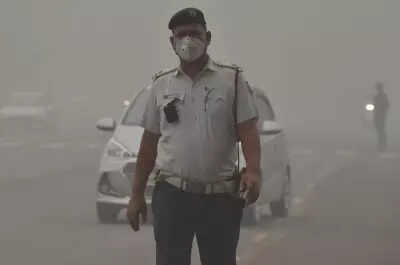[ad_1]

New Delhi: Residents of Delhi could see their life expectancy increase by up to 7.8 years if the city’s air quality were to meet the World Health Organization (WHO) guideline for particulate pollution, according to the latest report on the Air Quality Life Index (AQLI) published by the Energy Policy Institute at the University of Chicago (EPIC). The report underscores the severe impact of air pollution on health in India, particularly in Delhi, which remains one of the most polluted cities in the world.
Despite a 19 Percent reduction in particulate pollution across India, with PM2.5 levels dropping from 51.3 µg/m³ in 2021 to 41.4 µg/m³ in 2022, all 1.4 billion people in the country continue to live in areas where annual pollution levels exceed the WHO guideline of 5 µg/m³. Furthermore, 42.6 Percent of the population resides in regions where pollution levels are higher than the national air quality standard of 40 µg/m³.
The report highlights that if pollution levels in Delhi were brought down to meet WHO standards, the residents could potentially gain an additional 7.8 years of life expectancy. In comparison, in North 24 Parganas, the second most populous district in the country, residents could gain 3.6 years of life expectancy if similar reductions were achieved.
The impact of particulate pollution on life expectancy in India is significant. The report reveals that particulate pollution reduces the average Indian’s life expectancy by 3.6 years, making it a more serious health risk than other factors such as child and maternal malnutrition, which cuts life expectancy by 1.6 years, and tobacco use, which reduces it by 1.5 years. Additionally, unsafe water, sanitation, and handwashing practices reduce life expectancy by 8.4 months.
In the Northern Plains, the most polluted region in the country, approximately 540.7 million residents, accounting for 38.9 Percent of India’s population, are projected to lose an average of 5.4 years of life expectancy relative to WHO guidelines if current pollution levels persist. The report notes that while the overall reduction in pollution across the country is a positive development, the Northern Plains continues to face severe air quality challenges.
Significant improvements in air quality were recorded in 2022 in certain districts such as Purulia and Bankura in West Bengal, and Dhanbad in Jharkhand, where pollution levels dropped by more than 20 µg/m³. If these reductions are sustained, residents in these districts could see their life expectancy increase by up to 2.3 years.
The report also places India’s pollution levels in a global context, noting that particulate pollution remains the greatest external risk to human health worldwide. Its impact on life expectancy is comparable to that of smoking, and it is far greater than the risks posed by high alcohol use, transport injuries, or HIV/AIDS. The report emphasizes the unequal burden of pollution, with the most polluted regions in the world seeing life expectancy reduced by 2.7 years more than in less polluted areas.
The EPIC report calls attention to the need for stringent national pollution standards and effective enforcement to mitigate the health risks associated with air pollution. It highlights the importance of policy measures and sustained efforts to improve air quality, particularly in heavily polluted regions like Delhi, to ensure healthier and longer lives for the population.
[ad_2]
Source link



